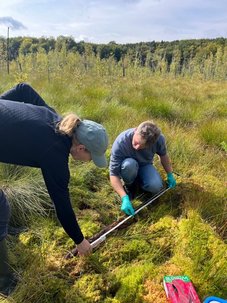Monitoring of peat microbial diversity through vegetation properties and its implication for carbon dynamics across European peatlands | MiDiPeat
Funding: Biodiversa+ (European Biodiversity Partnership)
Project period: 2024 - 2026
Cooperations:
Natural resources, Soil ecosystems, Natural Resources Institute Finland (LUKE), Helsinki, Finland
Faculty of Science and Technology, Institute of Molecular and Cell Biology, University of Tartu (UTAR), Tartu, Estonia
Faculty of Science, University of South Bohemia in Ceske Budejovice (USB), Ceske Budejovice, Czech Republic

Peatlands are wetlands that store a third of the world's terrestrial carbon and support local communities through recreation, natural products, and tourism. Yet, large areas of European peatlands have been drained for human use, increasing microbial decomposition, greenhouse gas (GHG) emissions, and carbon loss, accelerating climate change. Despite their key role in GHG balance, carbon storage, nutrient cycling, and water quality, microbial diversity in altered peatlands remains poorly monitored and understood.
MiDiPeat will harmonize data on microbial diversity in peatlands, examining its relationship with nutrient levels, land use, and management. By linking microbial diversity with plant traits and methane cycling, it will identify proxies for successful restoration, addressing biodiversity loss and ecosystem function recovery across environmental gradients.
MiDiPeat will provide valuable input for decision-making linked to land use and management of degraded peatlands.
GFZ leads the work package (WP3): Diversity and gene expression of methane cycling organisms in peatlands
To understand methane (CH4) regulation in peatlands subjected to different land-use and management practices, we will:
- study the diversity and gene expression of methane-producing and -consuming microbes using mesocosms,
- measure rates of potential CH4 production and oxidation in aerobic and anaerobic peat across nutrient gradients and land-use peatland types.
- Identify key organisms of CH-cycle using high-throughput sequencing of key functional genes of the CH4 cycle (e.g. mcrA, pmoA and mmoX) and quantitative (q)PCR. We will quantify abundance of putative anerobic methane oxidizing taxa (AOM) that potentially play an important role in terrestrial cycling.
Outreach: In collaboration with the GFZ School Laboratory Potsdam (https://www.gfz-potsdam.de/presse/gfz-schuelerlabor), we are developing an educational course titled “Rewetting of Peatlands.” This program will explore the formation and ecological functions of peatlands, the process of their rewetting, and their critical role as carbon sinks in mitigating global climate change. Designed for both schoolchildren and teachers, the course bridges cutting-edge scientific research with environmental education, fostering a deeper understanding of these vital ecosystems.
More information on the project can be found here: www.luke.fi/en/about-midipeat